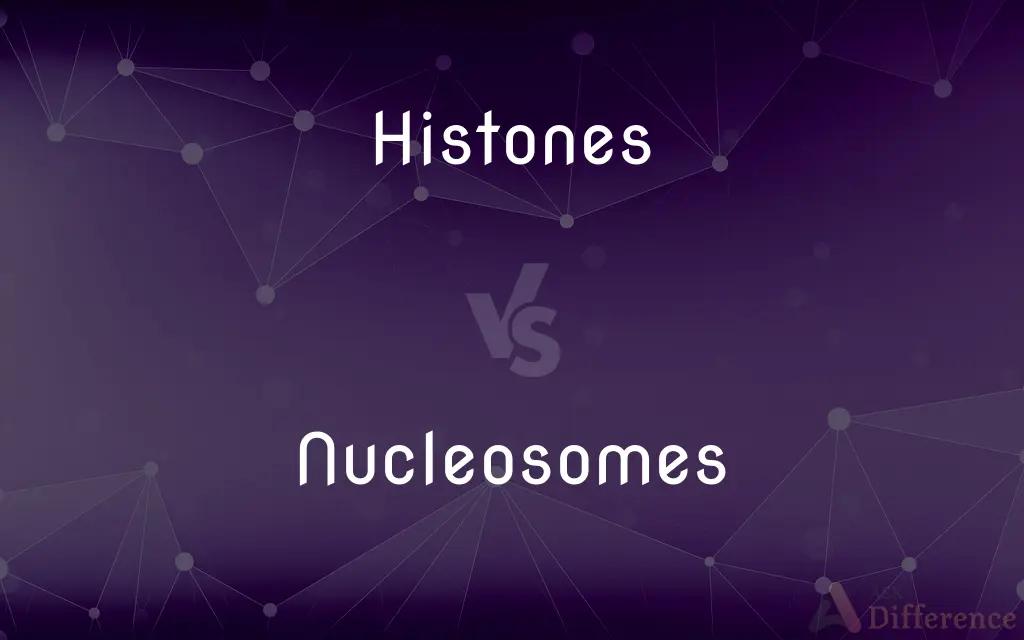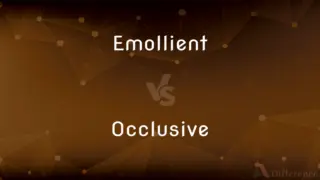Histones vs. Nucleosomes — What's the Difference?
By Tayyaba Rehman — Published on October 24, 2023
Histones are proteins that DNA wraps around, while nucleosomes are the structures formed by DNA wound around histone proteins.

Difference Between Histones and Nucleosomes
Table of Contents
ADVERTISEMENT
Key Differences
Histones and nucleosomes are central to the organization of DNA in eukaryotic cells. Histones are the core proteins around which DNA winds, enabling the efficient packaging of the long DNA molecules. They play a pivotal role in DNA condensation and gene regulation.
In contrast, nucleosomes represent the primary units of DNA packaging. When DNA winds around a histone octamer, typically containing two copies each of histone proteins H2A, H2B, H3, and H4, a nucleosome is formed. This structure resembles "beads on a string" when viewed through electron microscopy.
Histones, due to their positive charge, can bind to the negatively charged DNA, allowing it to coil around them. This interaction between histones and DNA is not just structural but is also dynamic, with implications for gene expression and regulation.
On the other hand, nucleosomes are the repeating subunits that make up chromatin, the material forming chromosomes. The positioning and modification of nucleosomes play crucial roles in the control of gene expression, DNA replication, and repair processes.
While histones are fundamental for the formation of nucleosomes, it's the latter, the nucleosomes, that directly interact with other chromosomal proteins and cellular machinery, influencing various genomic functions and processes.
ADVERTISEMENT
Comparison Chart
Nature
Proteins.
Structures formed by DNA and histone proteins.
Function
Facilitate DNA winding.
Primary units of DNA packaging in chromatin.
Components
Made up of H1, H2A, H2B, H3, H4 proteins.
Histone octamer and the DNA wrapped around it.
Role in Gene Regulation
Contribute through post-translational modifications.
Positioning impacts accessibility to transcription machinery.
Visualization
Can't be seen directly in electron microscopy.
Appear as "beads on a string" in electron microscopy.
Compare with Definitions
Histones
Histones are alkaline proteins in eukaryotic cell nuclei.
Without histones, DNA couldn't be compacted efficiently in the nucleus.
Nucleosomes
Structures formed by DNA wound around histone proteins.
Each nucleosome consists of DNA wrapped around a histone octamer.
Histones
Positively charged, binding to negatively charged DNA.
Histones have a positive charge, making them apt for DNA binding.
Nucleosomes
Nucleosomes are the basic units of DNA compaction.
Nucleosomes help in organizing the vast genomic content.
Histones
Exist in various types, including H2A, H2B, H3, and H4.
Among histones, H3 and H4 are most conserved across species.
Nucleosomes
Modified nucleosomes can influence genetic processes.
Certain modifications on nucleosomes play roles in gene regulation.
Histones
Participate in gene regulation.
Modifications to histones can turn genes on or off.
Nucleosomes
Impact gene expression by their positioning.
The placement of nucleosomes can hinder or facilitate transcription.
Histones
They assist in the packaging of DNA.
Histones allow the long DNA strands to fit within the cell nucleus.
Nucleosomes
They are repeating subunits in chromatin.
The chromatin is composed of a series of nucleosomes.
Histones
Any of several basic proteins found in association with the DNA in the chromatin of eukaryotes.
Nucleosomes
Any of the repeating subunits of chromatin found in eukaryotes, consisting of a DNA chain coiled around a core of histones.
Histones
Plural of histone
Nucleosomes
Plural of nucleosome
Common Curiosities
What are histones?
Histones are alkaline proteins around which DNA winds in eukaryotic cell nuclei.
Can DNA be efficiently packed without histones?
No, histones are essential for the efficient coiling and compaction of DNA within the cell nucleus.
How does the structure of a nucleosome appear?
Nucleosomes resemble "beads on a string" when viewed through electron microscopy.
Are histones involved in gene regulation?
Yes, modifications to histones can influence gene activation or repression.
What's the role of nucleosomes?
Nucleosomes are the primary units of DNA packaging, influencing gene expression and DNA replication.
What makes histones bind to DNA?
Histones are positively charged, allowing them to bind to the negatively charged DNA.
Do prokaryotic cells have nucleosomes?
No, prokaryotic cells lack nucleosomes. Their DNA organization is different from eukaryotes.
Are all histones the same?
No, there are various types like H2A, H2B, H3, and H4, each with specific roles.
What is the significance of histone modifications?
Histone modifications can influence chromatin structure, affecting processes like transcription, DNA repair, and replication.
Can modifications on nucleosomes affect genetic processes?
Yes, certain modifications on nucleosomes can play pivotal roles in gene regulation and other genetic processes.
Can nucleosome positioning influence gene activity?
Yes, the positioning of nucleosomes can impact the accessibility of genes to transcriptional machinery.
What forms the core of a nucleosome?
An octamer of histone proteins forms the core around which DNA winds to create a nucleosome.
How is the relationship between histones and nucleosomes best described?
DNA wraps around histones to form nucleosomes.
How do histones impact DNA structure?
By allowing DNA to wind around them, histones facilitate the formation of a compact, organized chromatin structure.
Can the positioning of nucleosomes change?
Yes, nucleosome positioning can be dynamic, changing in response to various cellular signals and processes.
Share Your Discovery

Previous Comparison
Emollient vs. Occlusive
Next Comparison
Methylcobalamin vs. HydroxocobalaminAuthor Spotlight
Written by
Tayyaba RehmanTayyaba Rehman is a distinguished writer, currently serving as a primary contributor to askdifference.com. As a researcher in semantics and etymology, Tayyaba's passion for the complexity of languages and their distinctions has found a perfect home on the platform. Tayyaba delves into the intricacies of language, distinguishing between commonly confused words and phrases, thereby providing clarity for readers worldwide.












































